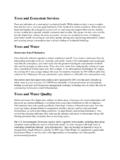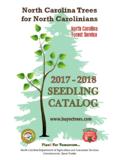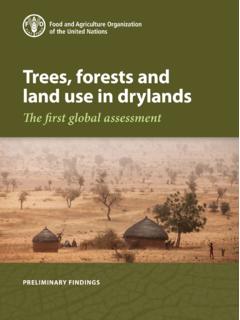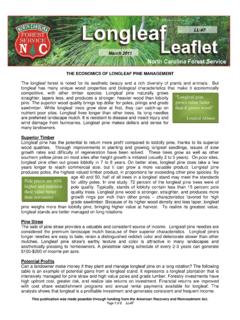Transcription of Ecosystem services in urban areas - Food and Agriculture ...
1 Ecological Economics 29 (1999) 293 301 ANALYSISE cosystem services in urban areasPer Bolunda, Sven Hunhammara,b,*aEn6ironmental Strategies Research Group,Natural Resource Management,Department of Systems Ecology,Stockholm Uni6ersity,Stockholm,SwedenbStockholm En6ironment Institute,Stockholm,SwedenAbstractHumani ty is increasingly urban , but continues to depend on Nature for its survival. Cities are dependent on theecosystems beyond the city limits, but also benefit from internal urban ecosystems . The aim of this paper is to analyzethe Ecosystem services generated by ecosystems within the urban area . Ecosystem services refers to the benefitshuman populations derive from ecosystems .
2 Seven different urban ecosystems have been identified: street trees;lawns:parks; urban forests; cultivated land; wetlands; lakes:sea; and streams. These systems generate a range ofecosystem services . In this paper, six local and direct services relevant for Stockholm are addressed: air filtration,micro climate regulation, noise reduction, rainwater drainage, sewage treatment, and recreational and cultural is concluded that the locally generated Ecosystem services have a substantial impact on the quality-of-life in urbanareas and should be addressed in land-use planning. 1999 Elsevier Science All rights : Ecosystem ; Ecosystem services ; urban areas1.
3 IntroductionHumanity is rapidly urbanizing, and by 2030more than 60% of the world population is ex-pected to live in cities (UN, 1997). But even ifhumanity is increasingly urban , we are still asdependent on Nature as before. Cities are, forexample, dependent on the large hinterlandsneeded to provide input and take care of outputfrom the city. In a study of the 29 largest cities inthe Baltic Sea region, it was estimated that thecities claimed Ecosystem support areas at least500 1000 times larger than the area of the citiesthemselves (Folke et al., 1997).* Corresponding author.
4 Fms, Box 2142, 103 14 Stockholm,Sweden. Tel.: 46-8-4023808; fax: (S. Hun-hammar)0921-8009:99:$ - see front matter 1999 Elsevier Science All rights :S0921-8009(99) , :Ecological Economics29 (1999) 293 301294 When humanity is considered a part of nature,cities themselves can be regarded as a globalnetwork of ecosystems . If compared with true,natural ecosystems , the man-made ones are how-ever immature due to features like their rapidgrowth and inefficient use of resources such asenergy and water (Haughton and Hunter, 1994).Odum (1971) even observes cities to be onlyparasites in the biosphere.
5 But there is also a presence of natural ecosys-tems within the city limits. As will be discussed inthis paper, the natural urban ecosystems con-tribute to public health and increase the quality-of-life of urban citizens, improve air qualityand reduce noise. Most of the problems present inurban areas are locally generated, such as thosedue to traffic. Often the most effective, and insome cases the only, way to deal with these localproblems is through local solutions. In this re-spect, the urban ecosystems are aim of this paper is to analyse some of theecosystem services generated by urban ecosystemsand discuss their importance for the quality ofurban life.
6 The emphasis is to identify the servicesand whenever possible also quantify and valuethem, with greatest relevance to cities in Europeand North America. Examples will be taken fromthe city of Stockholm in is difficult to generalize a discussion like theone in this paper to reflect the importance ofecosystem services in all cities of the world. Boththe actual service and its value are site-specificand can vary significantly around the world. Cit-ies differ, since they are built in all kinds ofclimates, their sizes vary from small towns to hugemegacities, and the wealth of city inhabitantsranges from extreme poverty to excessive , the identification and valua-tion of Ecosystem services could be viewed as aninput to a cost-benefit analysis (CBA) aiming atmore efficient land-use in urban areas .
7 Thebenefits of ecosystems are often neglected in ordi-nary CBAs and if increased values (both mone-tary and non-monetary) could be allocated toecosystems, the results of CBAs on new begin with a general discussion of urbanecosystems and their Ecosystem services . A num-ber of local and direct services relevant for Stock-holm are then discussed. The paper is concludedby a synthesis and a discussion on the conse-quences for land urban ecosystemsAn Ecosystem can be defined as a set of inter-acting species and their local, non-biological envi-ronment functioning together to sustain life (Moll and Petit, 1994).
8 However, the bordersbetween different ecosystems are often diffuse. Inthe case of the urban environment, it is bothpossible to define the city as one single ecosystemor to see the city as composed of several individ-ual ecosystems , parks and lakes (Rebele,1994). For simplicity, we have chosen to use theterm urban ecosystems for all natural green andblue areas in the city, including in this definitionstreet trees and ponds. In reality, street trees aretoo small to be considered ecosystems in theirown right, and should rather be regarded as ele-ments of a larger identify seven different urban ecosystemswhich we call natural, even if almost all areas incities are manipulated and managed by man.
9 Theecosystems are street trees, lawns:parks, urbanforests, cultivated land, wetlands, lakes:sea, trees are stand-alone trees, often sur-rounded by paved ground. Lawns:parks are man-aged green areas with a mixture of grass, largertrees, and other plants. areas such as playgroundsand golf courses are also included in this forests are less managed areas with a moredense tree stand than parks. Cultivated land andgardens are used for growing various food consist of various types of marshes andswamps. Lakes:sea includes the open water areaswhile streams refers to flowing water. Other areaswithin the city, such as dumps and abandonedbackyards, may also contain significant popula-tions of plants and animals.
10 It should be possible,however, to place most urban ecosystems or ele-ments in one of the above mentioned , :Ecological Economics29 (1999) 293 301295 Our classification is crude and has to be adoptedto site-specific has a large and varied ecologicalstructure. In the City of Stockholm, parks andgreen space occupy 56 km2(26%), and water areascover 28 km2(13%) of the total area of 215 km2(Miljo fo rvaltningen, 1995). This is considerablymore water and green space than possessed bymost other cities, and gives Stockholm its uniquecharacter. The city is situated on a number ofislands between the fresh water lake Ma laren andthe brackish Baltic Sea.















